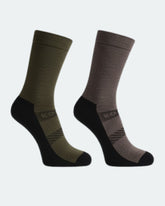To Antarctica & Back – Interview with a Carbon Studies Expert
“World’s coldest desert”. That is how I would like to describe Antarctica. Isn’t there a very vast and unattainable feeling when you hear about the only continent on Earth which has never been home to any human tribe or indigenous race? Working for a technical winter and travel wear brand, you meet people who travel to the Americas, Europe, the Middle East, or even Slavic countries. But it is not very often that you meet someone who is planning to visit Antarctica. Maybe that is why meeting Mr. Harish Borah made me so curious. Harish is an expert in ‘carbon studies’ with a body of work in the UK/EU and India, a receipt of Ratan Tata Grant, is on Economic Times Top 25 ‘PlanetBuddy’ List, and a member of ‘Technical Advisory Committee’ for GRIHA (an Indian Green Building Rating System). Most importantly, he is an aspiring marathon runner :)
He was the first person I met who was traveling to Antarctica. During his visit to Kosha, when he was going through our layers and confirming the temperature grading and quality, I was brimming with so many questions on my mind about the expedition he was about to make. Since that was not the right time, I decided to hold off my spurting questions and later approached him for a quick interview. Not only was he happy to be of assistance, but he also agreed to co-author this post, so that he can showcase the Antarctica that he had experienced to our readers without losing the essence much.
So, without further ado, let’s dive in!
Harish, I remember you telling me that you will be going for the 2041 ClimateForce Antarctica Expedition. So, what exactly is the 2041 ClimateForce Antarctica Expedition?
“The 2041 ClimateForce Antarctica Expedition was an extremely unique undertaking by Robert Swan. Robert is not only a polar exploration legend (being the first human to trek both the north and south poles), but an inspiring climate-action leader, and a UN Ambassador.
Passionate about the Conservation of Antarctica, Robert shortlisted a diverse team of 150 climate action leaders from 35 countries over the last 4 years, to participate in the ongoing global movement that presses for the continuation of the 'Antarctic Treaty'. The Antarctic Treaty, which came into force in 1961, set aside the continent as a scientific preserve and banned mineral exploitation and military activity in it.
I had the opportunity to be a part of this team and received my invitation in April 2021.”
Did you hear that?! He was shortlisted to be part of the expedition from over 35 countries! 35 countries!!!
“With a high density of individuals from the climate action movement on board”, he continued,” the expedition also laid out an exceptional ecosystem for knowledge exchange between the expeditioners on climate action, within the backdrop of Antarctica, where the first signs of human-induced climate change are emerging.”
So what was it like? Or in other words, how was your experience traveling to the iciest and uninhabited part of the planet?
“There are few places in the world where there has never been war, where the environment is fully protected, and where scientific research has priority. While I have been lucky to have traveled to several countries in the last few years, I knew this one was going to be very different, right from the get-go.”
Isn’t that beautiful, a country with no war. Makes one wonder, huh?
“But little did I know that Antarctica would have such an impact on me. The more I reflect on my journey, the more I become unsure how to describe this place of remarkable extremes. Vast. Untouched. Serene. Out-Worldly. Emotional. They all feel right, yet insufficient. If you ask me today, I think Antarctica best remains un-described.”
And yet his words describe that mystic white land full of wonder so well.
That is so beautiful. I have always imagined Antarctica to be somewhere non-reachable. How did you get to Antarctica?
“Well, that’s a whole another story too. Especially with the Pandemic in the background (rather a foreground !), but about that later.
To begin with, all of us - the 150 expeditioners, Robert, and his team – were expected to assemble in a small Argentinian town called Ushuaia (also dubbed the southernmost city in the world) in March 2022. Which is what we did. This was the first time; we were meeting each other; having kept in touch via emails until this point, for close to a year.
Ushuaia served as the base for all our final safety briefings and preparations. Once we were ready for what was to come, we set sail to Antarctica on an 1100-km-plus voyage that would take us about 36 hours to complete.
Sailing for 1,100 kms in a foggy sea trail with nothing but water as far as the eyes can see; with rhythmic but extremely cold wind and waves gushing all day and night, does a lot to you. You lose the sense of time and direction, to say the least.
As if that was not enough, our voyage was heading to Antarctica through the infamous Drake Passage. It’s among the roughest seas there is, on our planet, with waves 7-12 meters high smashing our vessels through most of the 36 hours passing.”
36 hours!!! Wow, can’t imagine.
While we are on this topic, when I was researching about the Antarctica experience, I heard this interesting fact that your body reacts differently to such a cold surrounding. So, were there any preparations that you had done to get your body and mind physically ready for the expedition?
“Oh yes! Absolutely. I knew Antarctica was going to be challenging. Robert had given us a good heads-up. Plus the more I read accounts of those on similar expeditions during my preparation, the more I understood I would risk too much if I entered Antarctica without preparing.
By the time of my selection for the expedition, I was already beginning to run (with an intention to compete in a full marathon someday), which certainly helped. However, as I got closer to the departure date, I began training with physio-therapists to prepare physically (especially lower body) and build endurance. This training came in absolutely handy, during the expedition!
The mind was a game of its own. To our benefit, we had a good few months to gradually sink into what was to come. Plus Robert and the team kept talking to us every few weeks to give us a sense of things to expect. These bits help psychologically stay on course. Add to this, the amazing company of people that I had the pleasure of doing this expedition with."
That’s nice. I also read online that the average temperature on the Antarctica coast would be around -10deg Celsius with dry, cold blizzards frequenting the region. Was that the condition when you went there? What was the range of temperature there?
“Before I answer that, let me throw in some context here. Antarctica enters winter by the end of March. This is when the sea begins to freeze to form ice sheets and no more voyages are possible. For context, in winters, average annual temperatures are well below the freezing point at around -49°C, with the lowest ever recorded at -82.8°C. Wind speeds that reach up to 320 km/h. When we headed out in mid-March, we were probably the last voyage out of Antarctica, this year before winter came.”
Sea freezes - now that is something!
“So when we entered the Antarctica region, we were experiencing this transition of the region from summers to winters.
We hit relatively milder temperatures of -10°C, along the continent’s Western Peninsula. However, it was the continuously blowing chill wind at about 80km/hour (with occasional snow and high-speed gusts)that made things challenging."
Hmm, scary. How did you dress up for this harsh weather? What kind of clothes or accessories should you carry?
“Well, dressing up for Antarctica is to effectively dress oneself up in layers and layers of clothing!

Base Layer - Thermal Wear for Men. As many as you need. Ideally two layers. Add to that layers of Parka Jacket for Women and a windcheater. This combination is to keep you warm and protected, not only from the low temperatures but also from extremely challenging cold wind gusts.

Balaclava and Buff for your head/neck. Sunglasses with 100% UV protection to protect your eyes. Waterproof Gloves for Men for your hands. Layers of socks, and a pair of muck boots that can help you walk the ice.

As you can imagine, getting all this right was very tricky. Everything I was packing had to work in Antarctica condition, and there was no room for error.
I could have never gotten this right without Yuktie and the team at Kosha. Thank you! I remember constantly going back to Usman in the Khar (Mumbai) store to help me figure things out.”
Are you kidding? The honor was all ours :)
You mentioned the correct layers and dynamic weather. The first one was controllable and the later is the beauty of nature. Apart from these, what were some of the challenges you faced on this expedition?
“There were many. To different degrees. But many. From finding the right training, raising the much-needed funds, traveling through the Drake Passage, the extreme conditions of Antarctica; to finding a footing again in our everyday world upon return.
But it was the ongoing Pandemic at the time – that really sticks out, at the moment, when I think about it. It remained a constant element of challenge, and uncertainty, throughout the whole process.
Each wave of covid, brought new logistical nightmares since the shortlisted expeditioners were spread out globally. Considering this, it was important to us that national borders remained open to allow travel to and assembling in Ushuaia.
In fact, in June 2021, when global covid cases began to peak once again, our expedition had to be called off and pushed from the original November 2021 dates, on account of the safety risk it brought with it.
And that was not all. Once the team assembled in Ushuaia, we undertook covid tests every morning for proactive detection of the virus. In fact, a day before the boarding, 4 co-expeditioners tested positive and had to be left behind, to protect the Expedition as a whole. This was very saddening. But, the risk of having the virus on the ship, which would carry 150 individuals to far remote Antarctica, was too high.
The tests continued, over the next few days, even while on the Antarctica Waters, to constantly look for any early signs”, Harish recalls.
What about some of the most memorable experiences you had on this journey?
“Looking back the whole expedition feels like a one-grand experience. I am aware of how much of an opportunity this was.
At the moment, as I am doing this conversation with you, I am overwhelmed with memories of silent moments I shared with massive ice landscapes, blue waters, penguin colonies, and whales from the edge of my zodiacs vessels.” There is a depth and fondness of the memories in his words.
“Also, the polar plunge! Yes, I also had an opportunity to dive into cold icy Antarctica waters. It’s a different story that it’s difficult to bear for more than a minute or two. But that was something, I won't forget.” A polar plunge is an activity wherein you enter the water body at a low temperature.
“Another thing that I have to mention is the conversations I often broke into with teammates (now friends!) in the most remote part of the world, away from the world of the internet. I have come across some very inspiring stories – that I will hold close forever. It’s interesting how the climate conversation has brought in individuals from all walks of life; and the reinforcement of the idea of how much we have in common as humans living on our one true planet.”
Beautiful!
What are some of your safety tips for people planning to do this expedition?
“To keep this short and crisp, here are my five pointers”, he explains:
“One. Prepare yourself physically. Enough to be able to take on Antarctic conditions.
Two. Prepare yourself mentally. Enough to be able to withstand isolation for a few days, in case worst comes to worst.
Three: Get yourself the right insurance for emergency evaluation and medical protection.
Four: Get the right clothes. You get this wrong, and you are setting yourself up for trouble.
Five: Finally, talk to experts who have been to such conditions, and take the time to listen to their stories. You will be surprised at the amount of wisdom they hold.”
If you were to plan another expedition like this, would you change anything about it?
“No!”
Now, coming to the topic of the hour. Antarctica has been a case of constant interest to scientists mainly due to the emerging evidence it provides of climatic impact. Can you talk a bit about that?
“I think, first, let’s get a little perspective on why Antarctica is important to our planet and our climate system”, explains Harish.
“To begin with, Antarctica plays a very important role in preventing our planet from overheating. Acting like a giant mirror, the white (ice) surface of Antarctica reflects a large portion of the incoming solar radiation back into space. Further, Antarctica’s cold waters absorb a large portion of atmospheric heat-regulating our climate systems. And that was not enough, Antarctica is also home to the tiny organisms (plankton varieties), that absorb a remarkable 23 million tonnes of atmospheric CO2 annually! This is important against the backdrop of the fact that the current climate destabilization is largely a result of high increased atmospheric CO2 concentration; and we cannot compromise on any natural cycle that absorbs CO2 back from the atmosphere. Personally, the expedition was an intimidating self-realization of the fact that Antarctica - which sits so far away from the everyday human world, is also gradually falling to human-induced climate change.
Heating up synchronously with the rest of the planet, Antarctica has warmed up 3 times more than the average global warming recorded, in just the last 50 years. This has a profound impact on the stability of the planet’s climate system. Besides, the Antarctic ice melting will lead to irreversible sea-level rise, leaving more than 150 million people in island nations and coastal cities worldwide vulnerable: and creating a new category of climate refugees in an already politically sensitive ‘refugee scenario’ of our current world order.”
That is huge Harish.
Last, but not least- how can we, as the readers of this journal, or regular people, contribute to reducing the risk to the planet?
“To be fair, our 21st-century societies are so deeply rooted in fossil fuels, that there is no such thing as ‘regular people’ in the climate conversation. We are all active participants in the ongoing climate crisis - sometimes consciously; and oftentimes unconsciously.
Over the last few years, there is a rising public consciousness around climate change, which is extremely promising and all-powerful.
While self-regulation and sustainable choices often seem to dominate the public consciousness, which is important; I have always felt the true nature of this power lies in leveraging the collective consciousness of our society to send clear signals to governments and businesses of a preferred no-carbon-emitting-future.
Personally, I believe, nothing has as much impact as applauding ‘good public policy/corporate action’ that favors reducing greenhouse gas emissions; and constructively critiquing those that fail to do so. Also, it helps if you take the time to talk to others about the climate conversation”, he concluded.
Harish has been a big advocate of conversations, and meaningful workshops – that help new participants go behind the scenes on the emission problem, and the various solutions that are already at play. For years now, he has been designing and delivering similar workshops with his initiative OnePointFive Tribe (www.theonepointfivetribe.com ). You can also keep a tab of their sessions on the social media handle @onepointfivetribe (Twitter, Instagram & LinkedIn).
We often imagine climate change as something that is happening far, to someone somewhere. But getting a first-hand view of these experiences can be an eye-opener. But it's still not late. Let’s join our hands together and ensure that whatever small efforts we can do to minimize damage to the earth are followed.
Remember, there is only one life and there is only one earth :)
Editor’s Picks
Men's Pack Of 2 Merino Wool Cushioned Technical Socks
- ₹2,076.00
₹3,580.00- ₹2,076.00
- Unit price
- / per
Woolmark Full Sleeves Thermal Top For Women
- From ₹1,255.00
- From ₹1,255.00
- Unit price
- / per
Woolmark Full Sleeves Thermal Top For Men
- From ₹1,890.00
- From ₹1,890.00
- Unit price
- / per
Women's Classic Merino Wool Crew Length Socks
- ₹1,014.00
₹1,690.00- ₹1,014.00
- Unit price
- / per
Women's Full Zipper Hoodies
- ₹2,800.00
₹5,600.00- ₹2,800.00
- Unit price
- / per













